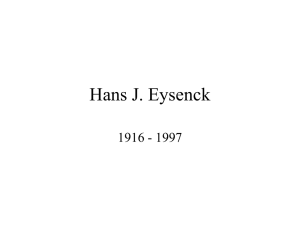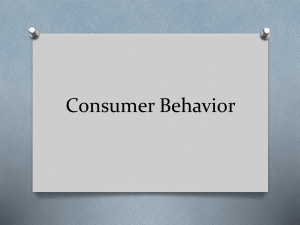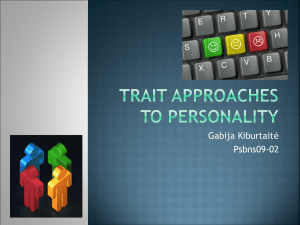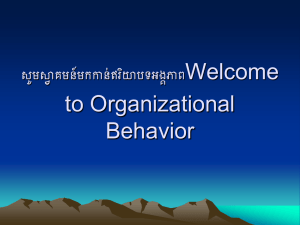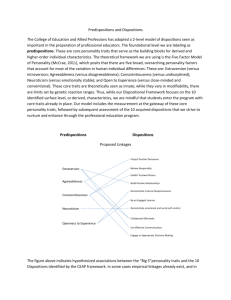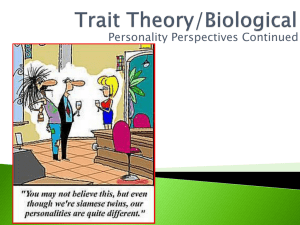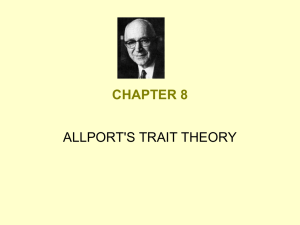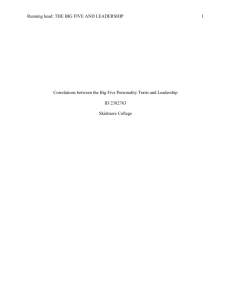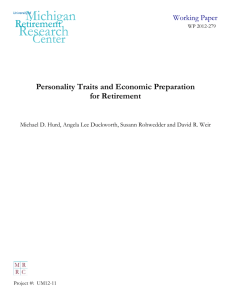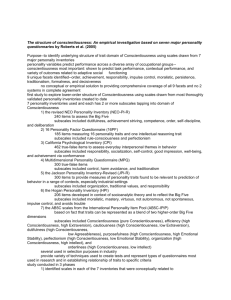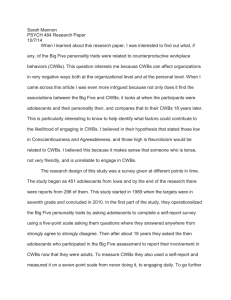The Big 5 - WKU
advertisement
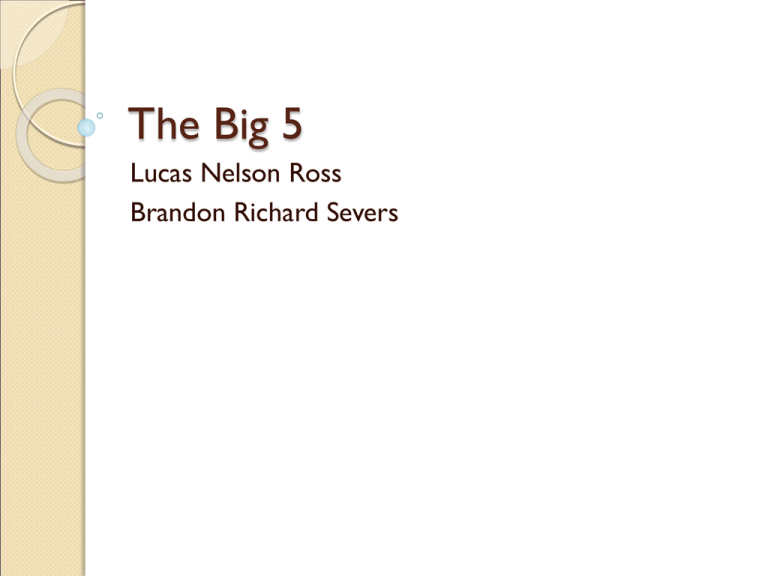
The Big 5 Lucas Nelson Ross Brandon Richard Severs Overview What are the Big 5? History Dimensions Criticisms Psychometric Properties Big 5 and Job Performance, Job Satisfaction and Leadership What are the Big Five? Five broad dimensions of personality traits. Five basic source traits that make up the fundamental building blocks of personality. Collectively, a taxonomy of personality traits A coordinate system that maps which traits go together. Five trait clusters that are strongly internally correlated and not strongly correlated with one another. History of Big Five Lexical Hypothesis assumes important human traits will be… ◦ represented in all languages ◦ have many nuanced synonyms Allport and Odbert: ◦ Went through an English-language dictionary and discovered more than 4,000 words that described specific personality traits. Cattell: ◦ Reduced 4,000 terms to about 171 characteristics ◦ Used factor analysis to identify traits closely related to one another. ◦ Eventually reduced his list to 16 key personality factors. Eysenck: ◦ Three dimensions Introversion-extroversion Neuroticism-emotional Psychoticism History of Big Five Lew Goldberg coined the term “Big Five”. Began with a study by Tupes and Christal (1958, 1961). The Big Five structure was derived from statistical analyses of which traits tend to co-occur in people’s descriptions of themselves or other people. ◦ A factor analysis was used to analyze how various personality traits are correlated in humans. Costa and McCrae ◦ Big Five Model ◦ Neuroticism, Extroversion, Openness to Experience, Agreeableness, Conscientiousness. Neuroticism The tendency to experience negative emotions, such as anger, anxiety, or depression High ◦ ◦ ◦ ◦ ◦ ◦ Anxiety Self-consciousness Depression Vulnerability Impulsiveness Angry hostility Low ◦ ◦ ◦ ◦ Calm Even-tempered Unemotional Hardy Neuroticism Individuals high on Neuroticism have more bad feelings and psychological distress because… ◦ Generate more stressful situations by getting into arguments, etc. ◦ React more strongly negatively to stressful events. ◦ Direct bad feelings associated with Neuroticism even without stressors. Individuals have more psychosomatic symptoms, irritation, anger, and nervousness. Extroversion Characterized by positive emotions, surgency, and the tendency to seek out stimulation and the company of others. High ◦ ◦ ◦ ◦ ◦ ◦ Gregariousness Activity Level Assertiveness Excitement Seeking Positive Emotions Warmth Low ◦ Reserved ◦ Loner ◦ Quiet Extroversion More resistant to distraction, cognitive interference, and perform better on tasks requiring divided attention. Its sociability is related to positive affect. Impulsivity is related to negative affect Openness to Experience A general appreciation for art, emotion, adventure, unusual ideas, imagination, curiosity, and variety of experience. High ◦ ◦ ◦ ◦ ◦ ◦ Fantasy Aesthetics Feelings Ideas Actions Values Low ◦ ◦ ◦ ◦ Down-to-earth Conventional Uncreative Prefer routine Openness to Experience Alternately labeled culture, intelligence, openness. High in very creative people. Correlated with… ◦ ◦ ◦ ◦ ◦ ◦ Active intelligence Education # of career changes Aesthetic interests and sensitivity Intellectual absorption Broad values Agreeableness Tendency to be compassionate and cooperative rather than suspicious and antagonistic towards others. High ◦ ◦ ◦ ◦ ◦ ◦ Straightforwardness Trust Altruism Modesty Tendermindedness Compliance Low ◦ Aggressive ◦ Ruthless ◦ Suspicious Agreeableness Includes altruism, affection, humaneness, sincerity Most related to good parenting in mothers. Conscientiousness Tendency to show self-discipline, act dutifully, and aim for achievement. High ◦ ◦ ◦ ◦ ◦ ◦ Self-discipline Dutifulness Competence Order Deliberation Achievement striving Low ◦ Lazy ◦ Aimless ◦ Quitting Conscientiousness Most related to success across jobs and situations. ◦ College level individuals high in Conscientiousness predicts job success years in the future Related to good scores on integrity tests Criticisms of the Big Five The model is theory-driven rather than determined by empirical inevitability. The Big Five have repeatedly been found to be non-orthogonal and correlate with each other. Cannot encompass all of human personality Too Broad Not enough clarity over what the factors actually mean Does not make any advances in getting towards an understanding of what makes up personality. Criticisms of the Big Five Block (1995) suggests that the lexical hypothesis is a "psychologically insufficient" hypothesis, drawing on the observation of McCrae and Costa (1985) that psychologists have uncovered important aspects of personality that were not encoded in the language There are many aspects of personality that cannot be captured with a single-word term Big 5 Traits Because the Big 5 is so broad, there is some variation from study to study about the dimensions themselves and what they include Question became “Which Big 5 should be used?” as different researchers simply preferred different labels in their research As a result, a set of judges combined over 300 adjectives or traits to form the Adjective Check List Big 5 Traits Big 5 Traits In another study, certain clusters of personality traits were determined to be independent from a Big 5 dimension Religious, devout, reverent = .07 Sexy, sensual, erotic = .13 Egotistical, conceited, snobbish = .16 Humorous, witty, amusing = .13 Psychometric Properties Because there are many scales that measure the Big 5, John and Srivastava (1991) looked at the validity and reliability of three commonly used instruments: ◦ NEO-FFI ◦ TDA ◦ BFI Reliability Validity Big 5 and Job Performance Previous research concluded that personality tests had low validity for predicting job performance In a meta-analysis by Barrick & Mount (1991), they compared the Big 5 dimensions to three job performance criteria and five occupational groups The results indicated that only one dimension, conscientiousness, showed significant relationships between performance and the groups. Big 5 and Job Performance Validity for Conscientiousness was .2 which suggests the trait is important to the accomplishment of work tasks in all jobs Extraversion was found to be a valid predictor for two occupations: managers and sales Openness to experience dimension a valid predictor of training proficiency Big 5 and Job Satisfaction In a meta-analysis by Judge, Heller, and Mount (2002), they found moderate correlations of job satisfaction with Neuroticism, Extraversion, and Conscientiousness Big 5 and Job Satisfaction Big 5 and Leadership Can having certain personality traits predict that an individual will be a leader? Transformational leadership (TL) inspires followers with a vision beyond their own selfinterest Uses four dimensions: ◦ ◦ ◦ ◦ Idealized influence Inspirational motivation Intellectual stimulation Individual consideration Big 5 and Leadership Results show that correlation between Big and TL is .40 and the strongest dimension was agreeableness at .32 Support the construct of TL and generalizes across levels of organizations Correlations between TL and leader effectiveness are not perfect though Big 5 and Leadership Study by Judge et al. (2002) studied the Big 5 traits and their relationship to leadership emergence and leadership success They found extraversion and conscientiousness to be related to leadership emergence Also, they found the Big 5 dimensions to be useful in predicting dispositional qualities of leadership, but there is little understanding as to why these traits predict leadership Big 5 and Networking Intensity In a study by Wanberg, Kanfer, and Banas (2000), predicted individual differences in networking intensity Participants completed items that assessed the term networking intensity All dimensions correlated in some way with networking intensity and job-search intensity Only Extraversion and Conscientiousness predicted networking intensity while the others were non-significant



